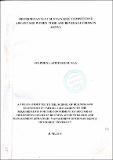| dc.description.abstract | Urbanization is proceeding at a high pace with urban dwellers expected to outnumber rural population in the near future. The demand for processed foods with shorter preparation periods that offer convenience for the urban population is high and is set to increase. This calls for higher processing capacity in the food and beverage industries. Stiff competition is already being experienced in this industry in Kenya which calls for firms to position themselves strategically to survive. Investment in competitive strategies by companies in this industry is critical for their survival and will determine their success or collapse in future. This study aimed at empirically analyzing the nature of competitive strategies companies in the food and beverage sector engaged in to acquire sustainable competitive advantage, and the drivers underlying that competitiveness. Purposive sampling of 95 food and beverage firms located in Nairobi and Mombasa and their environs and registered with the Kenya Association of Manufacturers was done. The study was designed as a survey of all the firms targeting the chief executive, the finance/marketing manager or the human resource manager as respondents. The study design was descriptive. Data was collected using a standardized questionnaire. The data was then coded and analyzed using the Statistical Package for Social Sciences (SPSS). From the 95 firms surveyed, 32 successfully participated giving a response rate of 33.7 percent. Statistical analysis revealed that cost leadership generic strategy was significant as a predictor of sustainable competitive advantage while differentiation was not. On effects of firm resources on sustainable competitive advantage, the study found that effects of organizational structure were statistically significant and critical to success of firms in this industry. The use of human capital in innovative adaptation was found statistically significant for owner/chairman and executive management. Dynamic operational efficiency was found to be driven mostly by efficiency of production processes which was statistically significant while effects of selected macroeconomic factors of inflation, exchange rates and interest rates were not statistically significant. The failure at significance tests of macroeconomic factors meant that the factors were not critical at influencing the business environment of the food and beverage firms in Kenya. The findings of this study are important in academia, industry, and government by adding to the body of knowledge and enlightening on the competitive nature of the food and beverage industry in Kenya. The findings are enriching in the developing areas of resource capability configurations (resource based view of the firm) and the linkage with generic strategies in the Kenyan environment. The findings will be useful to investors especially in the food and beverage sector which is the leading one in Kenya in the background of devolved governments and development of counties as well as rapidly growing urban centers which are the new frontiers for industrialization. Use of perceptual performance data for sustainable competitive advantage was found appropriate and longitudinal or time series studies as well as use of secondary data on performance is recommended for future research on this subject. | en_US |

